Last Updated: 3/26
A couple of things to note before reading:
- These rankings are for 10- and 12-team head-to-head category leagues with standard scoring and a starting lineup consisting of 1 C, 1 1B, 1 2B, 1 3B, 1 SS, 3 OF, 2 UTIL, and a shallow bench, and were created by me with input from Nick Pollack.
- Within the write-ups, I will call out individual players who would see value boosts or drops in alternative formats, such as rotisserie leagues, deeper leagues, or points leagues.
- Projected stat totals assume that teams each play at least 145 games unless specifically stated otherwise.
- I am more than happy to answer your questions, requests, and counter-points in the Comments!
3/8 Updates
- Keston Hiura moved from Tier 2 to Tier 3.
- Tiers 3 and 4 were re-ranked.
- Dominic Smith was moved from Tier 3 to Tier 4.
- Trey Mancini and Ryan Mountcastle were moved from Tier 5 to Tier 4.
- C.J. Cron was moved from Tier 6 to Tier 5.
- Evan White was added to Tier 6.
- Nate Lowe was moved from Tier 6 to Honorable Mention.
- Andrew Vaughn was added to Honorable Mention.
3/26 Updates
- Andrew Vaughn was bumped up.
- I reranked the lower tiers.
Tier 1: Elite
No. 1: Freddie Freeman (Atlanta)
Perhaps the only thing more amazing than Freeman’s 2020 NL MVP campaign is the fact that Statcast fully supported every bit of it. His actual batting average and slugging are basically identical to the expected versions, which is exceedingly rare when you have a .341/.462/.640 line.
While I’m not usually a fan of just dropping the Statcast percentile rankings due to them being a bit duplicative (for example, the first two rows of stats are pretty darn correlated), this particular one is accurate in displaying the extreme quality of the contact he made and how he consistent he was for the course of the season:
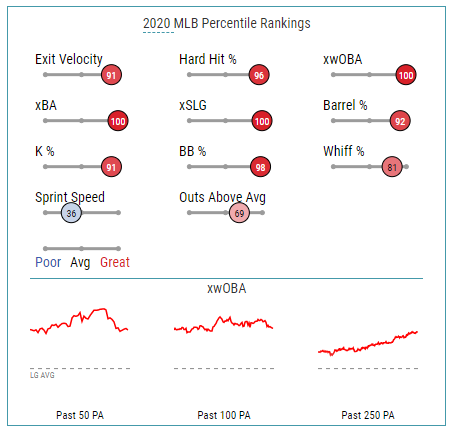
Simply put, Freeman is fantasy’s best first baseman. If you pick in the latter half of the first round and want to draft him with your first pick, I’m not going to stop you.
No. 2: Cody Bellinger (Los Angeles Dodgers)
I honestly thought that when I did the digging, I’d find something on Bellinger that I didn’t want to see. Maybe a glaring hole in his swing, or a disturbing rolling chart (don’t worry, I’ll have plenty of those for you later!). When I actually did the digging, though, all I found was bad luck.
I don’t want to make it sound like Lady Luck was too hard on him, though. He still hit 12 home runs and swiped six bases. That pace would have been good for more than 30 home runs and more than 15 steals over a full season. He also would have tallied up about 180 combined runs and RBI.
Where the luck came into play was his batting average. His .245 BABIP suggests he was opening umbrellas indoors on a routine basis, and the 45 point gap between his .239 actual batting average and .284 expected batting average confirms that something outside of Bellinger’s control put a major drag on his ratios.
All of that being said, if Fate once again drives a dump truck full of miserable luck to Bellinger’s driveway, you’re still looking at a top-five first baseman. If it doesn’t and lets Bellinger play the game the way he played it in 2019, you have a serious contender for a top-five overall pick in 2021.
Tier 2: Near-Elite
No. 3: DJ LeMahieu (New York Yankees)
Despite being the third-best option at the position, LeMahieu’s primary write-up is actually in the second base rankings, as that’s where he’ll most likely start for most fantasy managers in 2021. Here’s (most of) what I wrote about him there:
A reunion with the Yankees made the most sense from day one, as LeMahieu has been a different hitter since donning the pinstripes. After winning a batting title and logging many good-but-not-great fantasy seasons in Colorado due to limited power numbers but a robust batting average, the disciplined and versatile infielder showed that with a short porch and a robust lineup around him, he can hit for both contact and power, putting up a .922 OPS in his 192 games as a Yankee.
One interesting thing to point out about LeMahieu is that for fantasy purposes, New York is a much better place for him to hit than Colorado. While it may sound blasphemous, LeMahieu’s expected home runs by ballpark (as tracked by Statcast) across 2019 and 2020 would have been just 12 in Coors Field.
In Yankee Stadium, that number jumps to 40! Why? Because LeMahieu has learned how to take advantage of the short and low fences in the Bronx. In fact, none of the 81 batters with at least 10 home runs in 2020 had fewer expected home runs (according to Statcast) than LeMahieu, who came in at 6.8.
Now don’t get me wrong, this is not my attempt at suggesting the power is fake—in fact, far from it. Instead, this is my attempt at telling you that a return to New York was the ideal outcome for LeMahieu, as there are very few parks in baseball where he could translate his elite hit tool into 25 or more home runs, and New York is one of them.
I think many projection systems aren’t accounting for this quite enough, and would be very comfortable penciling in 25 or more home runs in 2021 to go along with a .300 or better batting average and tons of runs scored. Between that and his useful versatility, he should definitely be drafted among the first 15-20 hitters in your league.
No. 4: José Abreu (Chicago White Sox)
The AL MVP was nearly unstoppable in 2020, hitting an incredible 19 home runs and driving in 60 in just 60 games in his age-33 season. As it turns out, hitting third in one of baseball’s most explosive lineups can do a lot of good things for a hitter, especially one with the power of Abreu.
Despite Chicago fielding a less-than-stellar team on the South Side for a number of years, Abreu consistently found ways to drive in runners. In fact, in every season where Abreu has played at least 140 games, he’s driven in at least 100 batters and hit at least .284. That consistency can now be paired with a much more exciting offense that, by all accounts, should remain one of the best in the American League.
Age will eventually catch up to Abreu, as he’s a bit more reliant than average on his hand-eye coordination and would really rather make contact than take a walk (which is a White Sox philosophy that also plays into a personal trait), but until it does, you can count on a near-.300 batting average, buckets and buckets of counting stats, and 30-35 home runs. He probably won’t steal more than a base or two, but hey, don’t get greedy.
It’s worth noting that while his plate discipline is far from alarming, he takes a slight hit in OBP leagues as he’s pretty average in that category. I wouldn’t drop him out of this tier or anything—it just caps his upside by a little bit.
No. 5: Pete Alonso (New York Mets)
Following up his thunderous rookie season was going to be a tall order, and I think both he and fantasy managers can be satisfied with the 16 home runs, solid counting stats, and steady plate discipline.
Sure, the .231 batting average leaves a lot to be desired, and while I was able to say Cody Bellinger‘s bad batting average was bad luck, I’m afraid the underlying data doesn’t support the same conclusion here.
At first glance, bad luck really does look like the culprit—conventional wisdom says a .242 BABIP is pretty dang unlucky. Unfortunately, the conventional wisdom is a bit hollow, as a .242 BABIP actually might be because of his batted ball profile.
Alonso, you see, likes to get under the ball. His 43.9% fly ball rate was 17th amongst qualified hitters, and the average BABIP for he and the 16 guys above him was just .266. This makes some logical sense—fly balls that stay in the yard usually find their way into a glove, especially in big pitcher-friendly parks like Citi Field.
While you can’t really hope for much more than a .250 batting average, you have to respect the sheer power Alonso brings to the table. More than one outlet pegged him to have the rare 80-grade in raw power, and most public projections peg him for 40 or more home runs.
That power and the improved Mets lineup should mean plenty of home runs and RBI for the Polar Bear, and those in OBP leagues should consider placing him even higher on their boards due to his double-digit walk rates.
No. 6: Vladimir Guerrero Jr. (Toronto Blue Jays)
The only reason anyone has even considered the notion that Guerrero Jr. is a disappointment is because of the sky-high expectations we still have for the 21-year-old slugger. His generational combination of hit tool and power is just sitting there, waiting to be unlocked.
As with all very young sluggers, the key to analyzing their initial stint in the big leagues is to look for adjustments and improvements, and we’ve seen that to some extent with Vlad Jr. Breaking balls were a weakness in 2019, and he managed to chase them less often and whiff on them less often in 2020. Further, when he did make contact, he did more considerably more damage. He also managed to maintain his relative success against fastballs. Those are all very good signs.
An even better sign, though, would be him getting some lift on the ball. He had the 10th-highest ground ball rate in baseball in 2020, and is 5th among qualified hitters since the start of 2019. Vlad Jr. isn’t exactly fleet of foot and also pulls the ball quite a bit, which means a whole lot of shortstops and third baseman throwing him out at first base.
There is no doubt in my mind that he will be able to make the necessary adjustments to get the ball in the air and into the seats. He’s simply too good not to make that happen. He has the kind of bat skills to compete for numerous batting titles and hit a boatload of home runs.
The ceiling is a peak Miguel Cabrera, and while that’s an insanely lofty goal, I’m far from the first to suggest it. He needs to take some steps before he can realize that potential, but that’s why we aren’t ranking him in the first tier and why you probably aren’t drafting him in the first 40-50 picks.
No. 7A: Luke Voit (New York Yankees)
Despite playing half as many games as he did in 2019, Voit set a new career high in home runs with 22 of them in 56 appearances. This actually isn’t the first time we’ve seen the former Cardinal go on an impressive run, as he actually put up eerily similar numbers after he was traded to the Yankees in 2018, hitting 14 home runs in 39 games.
There’s no doubt that Voit has prodigious power, his injury history nags at me just enough to put him at the bottom of this tier instead of towards the top. He was hampered by a sports hernia in 2019 and a foot injury in 2020, each of which kept us from seeing his full potential.
In fact, the next time we see more than two or three months of solid production in a row will be the first—even his 2019 was very much a tale of two halves (139 wRC+ in the first half, 95 wRC+ in the second half) thanks to that pesky sports hernia.
There’s probably a 30-35 home run, 100 RBI bat with a .260 to .270 batting average in there if Voit can play a full season, but until he plays more than 130 games—a feat he hasn’t accomplished since his time in Cardinals’ minor league system—he’ll remain a slightly risky proposition, particularly for deep league managers who will struggle to find solid replacement value.
Shallow leaguers, on the other hand, can more afford to take this kind of risk due to the upside, and even if Voit misses time or plays through more injuries, you can probably find a hot bat to fill the void until he’s back to normal.
No. 7B: Keston Hiura (Milwaukee Brewers)
While we’ll probably think of him primarily as a second baseman for fantasy, it appears that Hiura will be shifting to first base with the acquisition of Kolten Wong. Below is the bulk of what you can also find in the second base rankings:
Hiura, who has been hyped as a top prospect for some time, now has 143 major league games under his belt, and to his credit, the final line looks great: 32 home runs, 12 stolen bases, and a .266/.338/.505 line.
So why isn’t he at the top of this tier? Simply put—volatility. If you told me that one of the three hitters in this tier were to stay healthy but also finish outside the top 15 at the position, I’d be very sad, but also would assume you’re talking about Hiura.
For all of the power and speed in this young man’s game, he also has just about as much swing and miss. In the shortened 2020, he had a whiff rate above 41% against all three of Statcast’s pitch groups (fastballs, breaking balls, and offspeed pitches). While he continued to show impressive barrel rates, pitchers appear to have identified two key cold spots for Hiura:
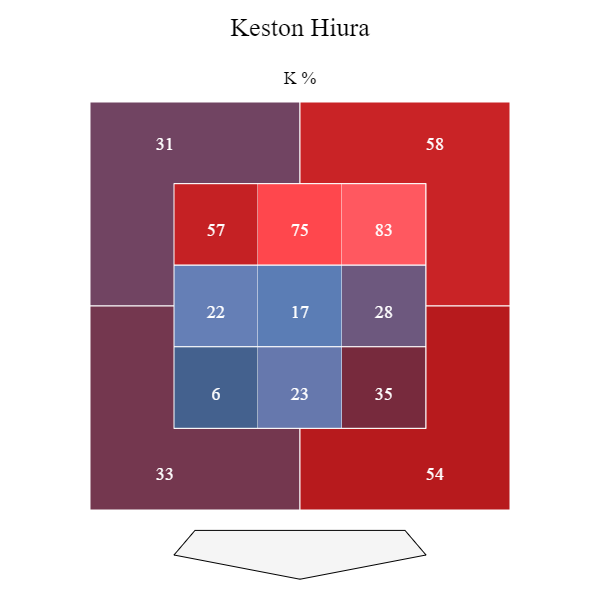
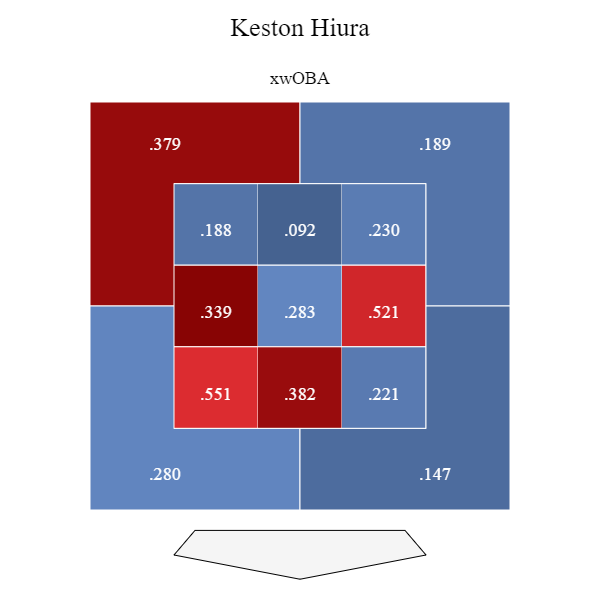
In other words, all of the best outcomes for pitchers happen in the same places: the top third of the zone, and away. All of the worst outcomes for pitchers also happen in the same spots: the middle of the zone, and down and in.
While executing pitches is far from a trivial matter, if a lowly part-time analyst like me can identify these cold spots, it’s fair to conclude that everyone in the Majors has already identified this.
Hiura truly has 35 home run, 15 stolen base upside with a .250-.270 batting average. I do believe we’ll see that some day. To get there, though, Hiura will have to figure out how to make more consistent contact and patch up these holes in his swing.
Tier 3: Solid
No. 8: Anthony Rizzo (Chicago Cubs)
Despite knowing it is true, and despite having the stats literally staring me in the face on the other half of my monitor, I can’t believe it’s been over three years since Rizzo hit 30 home runs in a season. Yes, I realize 2020 shouldn’t count, but even if you take his 155-game average from his 58 games in 2020, he falls just short (29.4 home runs).
I’m not going to call Rizzo old quite yet, as he’s actually over a year younger than I am and I am full of life and vigor (but also I have neck pain and I keep finding grey hairs in my mustache, so take that with a grain of salt, maybe). Age has yet to catch up to Rizzo’s power and ability to pile up counting states, though, and his .266 expected batting average and excellent plate discipline indicate his actual .222 batting average might have been more bad luck than skill erosion.
I think Rizzo can definitely rebound back to his old self and hit 30 home runs with a combined 180-190 runs scored and RBI, and even if some of the bad luck sticks around, a .265 batting average is entirely reasonable, and his OBP will likely settle in at a very strong .380 or so, which obviously boosts his value in leagues that use that stat. Points league players will also appreciate his low strikeout rates and high contact rates.
The floor Rizzo provides is more valuable than it might feel in your draft room, especially in a deeper format, but not every pick has to be flashy. Guys like Rizzo allow you to take risks in other parts of your draft and can keep you afloat while you look for the next lottery ticket add on the waiver wire to take you to the top.
No. 9: Paul Goldschmidt (St. Louis Cardinals)
Goldschmidt has always had good plate discipline, but 2020 took that to a whole new level. His 16% walk rate and 18.6% strikeout rate are nothing short of astounding, and it’s quite uncommon to see a 33-year-old slugger make such a change in his approach.
After trending in the wrong direction for several years in a row with respect to O-swing and swinging strike rates, Goldy all but transformed into a Joey Votto-like presence with respect to his plate discipline.
While these changes are certainly exciting, we also saw a bit of a power outage, as he hit just six home runs in his 58 games. This was the third straight season where we’ve seen Goldschmidt’s average exit velocity take a dip, this time settling at 89.2 MPH, three ticks below the marks we saw in 2015. It’s also the third straight season where his home run to fly ball rate has dropped, this time to just 10.7%, almost half of his career rate.
While it’s entirely possible that he may have just been a bit unlucky, or perhaps bothered by the bone spurs he had removed from his elbow at the end of the season, there’s just enough risk to push him down a bit in the rankings for standard leagues. Points and OBP leaguers, though, can keep him just a little higher, as he has .400 OBP skills.
No. 10A: Matt Olson (Oakland Athletics)
When a guy hits in the heart of the order and has the ability to hit 40 home runs, he’s a solid fantasy starter. That’s Matt Olson. Tons of power (he’s been in the top 10% of the league in average exit velocity for three straight seasons) and a shot to drive in 100 runners. He’s a bit cheaper to acquire than his other 40-home run contemporaries because his batting average is likely to be south of .245 and because the Athletics’ offense is more scrappy than it is over-powering.
It’s actually nice that I’m writing his blurb now, as I could use a bit of a mental break. Fantasy baseball doesn’t always have to be hard, folks. If you need a big power bat and don’t mind the bad batting average, take Matt Olson. If you play in OBP leagues, his high walk rate makes him all the easier to set and forget in your first base slot. If your league counts strikeouts, maybe move him down a peg or two.
No. 11: Max Muncy (Los Angeles Dodgers)
Muncy is similarly situated in the second and third base rankings, but with first and third having a deeper pool, most managers will likely opt to plug him in at second base. Here’s most of what I wrote about him in those rankings:
He’ll hit 30 home runs. He’ll walk 15% of the time. He’ll drive at least 90 runners and score at least 90 times. I feel good about all of that, and let’s be clear—that is a lot to feel good about. Strong production in three categories is a big deal.
The only thing that makes me feel at all uneasy was that he seemed to struggle with was keeping the ball off the ground. In what we saw in 2020, pitchers attacked him with fewer fastballs than ever before, which is meaningful as the vast majority of Muncy’s damage has been from smashing fastballs.
Pitchers, and in particular, right-handed pitchers, focused on locating breaking and offspeed pitches down beneath the zone and locating fastballs up and on the outer half of the plate. While Muncy still managed to take walks and hit home runs, it crushed his batting average.
While he was a bit unlucky on fastballs, both traditional and Statcast metrics indicate that the struggles against non-fastballs were very real.
This is not to suggest that Muncy is doomed forever—pitchers change how they approach hitters all the time, and hitters have always needed to adjust accordingly. I firmly believe the power and counting numbers will remain strong, but until Muncy finds a way to avoid weak contact on those pitches beneath the zone, his batting average floor and propensity for extended slumps could be rough.
Just to end this on a positive note—OBP players should be wholly unconcerned with his batting average woes, as even after hitting below .200 in 2020, he kept his OBP north of .330
No. 12: Alec Bohm (Philadelphia Phillies)
Frankly, the 44-game sample we saw from Bohm in 2020 is all we really could have asked for from the 24-year-old righty. The former first-round pick is praised mostly for his outstanding hit tool, which I’ve seen scouts grade as high as 70 on the 80-point scale. Bohm was able to flash that advanced bat right away for the Phillies, batting .338 with just a 20% strikeout rate in his first stint at the major league level despite just 63 games in Double-A ball.
While Bohm does have pop, I don’t think he’ll be a 30 bomb kind of hitter. Instead, he’s probably more of a 20-25 home run guy with a .290 batting average who can also swipe a handful of bags and is in a prime spot hitting second behind Andrew McCutchen and in front of Bryce Harper, J.T. Realmuto, and Rhys Hoskins. Assuming he can stay in that spot, counting stats shouldn’t be too tough to come by, either.
No. 13: Mike Moustakas (Cincinnati Reds)
While he finds himself at the bottom of the same tier as he did in the second base rankings, the extra depth of first base makes it more likely that managers deploy Moose at the keystone. Here’s what I wrote up for him in the second base rankings:
There’s no way that the Reds can possibly have the worst batting average in the league again, right? As a team, they hit a paltry .212 and were also in the bottom-five in runs scored and RBI. Their collective struggles can be seen in the batting lines for most of their lineup, and Moustakas is no exception. Most projection systems still have a lot of faith in his power, penciling in around 35 home runs for 2021. I am totally comfortable with that kind of projection, though like Muncy, his batting average will hold him back in terms of overall fantasy value.
One thing that shouldn’t worry you, however, is the perceived uptick in strikeouts. He had a 22.1% strikeout rate, a very reasonable total, though it was also six points higher than his career 16% rate. With Moose entering his age-32 season and having seen more breaking balls than ever before, it seems plausible to suggest that age may be catching up with his bat and that higher strikeout totals are ahead. I want to challenge that potential narrative before it even happens by using what you’ve likely already realized is my favorite narrative tool—the rolling chart:
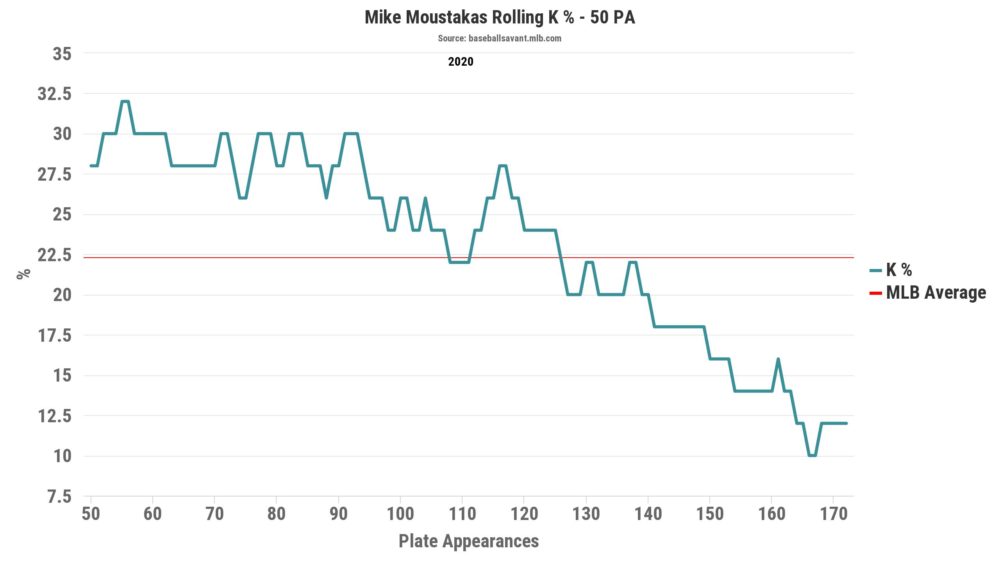
As you can see, Moose did strike out more often early in the season, but as time went on he corrected the issue to the point where there was really no issue at all. I am quite confident that if 2020 had continued, this “career-high strikeout rate” would have continued to be pulled closer and closer to his career norm, and we’d have no talking point at all in that regard.
While part of me occasionally toys with the idea of sliding Moose up higher on this list, his sub-par batting average and slightly lower counting stat ceiling playing for a streaky Reds team keeps him at the bottom of a very competitive tier.
It’s worth noting that unlike Muncy (and many other power hitters), Moose doesn’t have a long track record of high walk rates and doesn’t really get a boost in OBP formats. If there’s a reason to slide him up your board, it’s that you’re in the middle rounds of your draft and need someone who could also play second base or middle infield.
No. 14: Dominic Smith (New York Mets)
In his last 132 games, Smith has 21 home runs, 31 doubles, a .299 batting average, and a .937 OPS. That’s awfully good, though if you are wondering why I didn’t provide the counting stats, it’s because they weren’t very exciting. Turns out, all the Mets had to do was actually let Smith play and they could find themselves a useful player!
Of course, the Mets are under new management, and through free agency, they’ve managed to make their team more offensively intimidating without creating a log jam at the corners. A full season of Smith has considerable upside, especially coming off a season where he was in the top 10% of the league in most quality of contact metrics on Statcast and where he hit at least .264 and slugged at least .593 on all three major categories of pitch types (fastballs, breaking balls, and offspeed pitches).
While Smith doesn’t bat third or fourth like the rest of the guys ahead of him, the Mets lineup is deep enough on paper to accommodate a solid fantasy starter batting sixth, and he probably has the upside for 25-28 home runs and 160-170 combined runs and RBI. Most projections I’ve seen aren’t terribly bullish on his batting average, but there’s a chance he can prove them wrong and hits closer to .280 than .260.
Tier 4: Back-End Starters
No. 15: Rhys Hoskins (Philadelphia Phillies)
If batting average wasn’t a thing, Rhys would be in the tier above, and for OBP leagues, he probably should be up there due to his impressive walk rates that should once again be near 15% in 2021. Unfortunately, while he’ll take plenty of walks and hit upwards of 30 home runs, his upside is hampered by his extreme fly ball tendencies and slow sprint speeds.
Hoskins’ batted ball profile actually makes it tough for him to break the 100 RBI threshold, as pop-outs and fly outs can only drive runners in if they’re already on third base, and that’s the bulk of what he hits.
Batting fifth for the Phillies isn’t a bad spot for counting stats, though, and assuming he stays healthy, he can hopefully approach about 90 runs and 90 RBI. Those numbers are pretty handy in rotisserie leagues, but with these rankings being primarily directed at head-to-head categories, Hoskins’ prolonged slumps are so painful that he fell to the top of this tier as opposed to the bottom of the last one.
No. 16: Josh Bell (Washington Nationals)
2019 was a long time coming for many of Bell’s biggest boosters who praised his plate discipline and were certain he could unlock more power, and they were right. He smacked 36 home runs that season with a .277 batting average and 116 RBI.
The secret ingredient for his success had to do with his adjustments that converted a significant chunk of his grounders into fly balls. His average exit velocity is always impressive, and when he is able to unleash that power and get the ball in the air, that ball is going to leave the park pretty quickly.
2020, unfortunately, looked a lot like the pre-2018 and 2019 versions of Bell. The Bell that hits more than 50% of balls into the dirt isn’t a bad player—he could still swat 20-something home runs with an acceptable batting average—but in a position crammed with guys who can hit 30 or more dingers, there’s just not quite the same level of excitement.
Even a change in ballpark and lineup, both of which should surely be better than he had in Pittsburgh, isn’t quite enough to rile up fantasy managers, as no park in baseball has a fence that’s low enough to turn those grounders into home runs. If he’s able to show that he can get the ball in the air during Spring Training or early in the season, he should quickly move back up in the rankings.
No. 17: Trey Mancini (Baltimore Orioles)
I consider bumping Mancini up all the time (and in fact, I just did!). Lest we forget (and you should never forget about Trey), he hit 35 home runs with a .291 batting average when we saw him in 2019.
Yes, he did just go through treatment for Stage 3 colon cancer, but reports about him returning to baseball are all very positive:
https://twitter.com/JoeTrezz/status/1339292629989789696?ref_src=twsrc%5Etfw%7Ctwcamp%5Etweetembed%7Ctwterm%5E1339292629989789696%7Ctwgr%5E%7Ctwcon%5Es1_c10&ref_url=https%3A%2F%2Fcalltothepen.com%2F2020%2F12%2F16%2Fbaltimore-orioles-trey-mancini-to-be-full-go-for-spring-training%2F
Prior to his 2020 preseason diagnosis, he was a consensus top-15 fantasy first baseman in drafts and that was baking in some hesitation that he could repeat his 2019 success. Statcast seemed to greatly appreciate his handiwork with the bat and based on his interview with Joe Trezza, he’s been working out and feels as good as ever—which is obviously great news in both real life and fantasy.
At the very least, he felt good enough to be part of this video posted back in November on the Oriole’s Twitter account:
One swing at a time.
🎥: @TreyMancini | #F16HT pic.twitter.com/G5iitud0vW
— Baltimore Orioles (@Orioles) November 5, 2020
At the end of the day, Trey Mancini’s 2021 outlook comes down to whether the recovered Mancini picks up where he left off the last time we saw him.
The pre-2019 version of Mancini probably drops to the bottom of this tier, while the 2019 version threatens the top-10 at the position. While there’s significant risk in the unknown with respect to both his recovery and whether he can repeat his 2019 magic, I’m excited to see him come back to baseball.
No. 18: Ryan Mountcastle (Baltimore Orioles)
It was only 140 plate appearances, but they were a very strong 140 plate appearances for the soon-to-be 24-year-old slugger. Unlike a lot of other young power hitters, Mountcastle doesn’t have extreme strikeout rates and actually doesn’t walk much either.
Most projections peg him for about 25 home runs and a strong .280 batting average, which would be a solid follow-up to his .333/.386/.492 debut in 2020.
Batting sixth for the Orioles doesn’t currently look like an ideal situation due to the lack of depth in the lineup, but his plus pop and batting average make him an interesting corner infielder in deep formats, and his first base and outfield eligibility in most formats will give him a possible place at the end of your outfield in shallower leagues that use five outfielders.
No. 19: Eric Hosmer (San Diego Padres)
Like Bell, Hosmer hits a lot of ground balls, but unlike Bell, he’ll also hit a ton of line drives which can really keep his batting average up. The nice thing about Hosmer is that you should absolutely feel confident that you know what you’re going to get—his career line of .278/.336/.435 is pretty indicative of his talent, and he’ll hit somewhere between 18 and 25 home runs while stealing a handful of bases.
He’s also projected to hit right in the middle of a deep Padres lineup, which bodes well for his ability to pile up RBI. Getting to 100 certainly isn’t out of the question, as he got to 99 in 2019 with a weaker lineup.
There just isn’t much upside for more here, though. While you might be thinking that is due to the power and batting average spike in 2020, those numbers were largely earned earlier in the season. The rolling chart for his expected wOBA does a good job telling us exactly how his season played out:
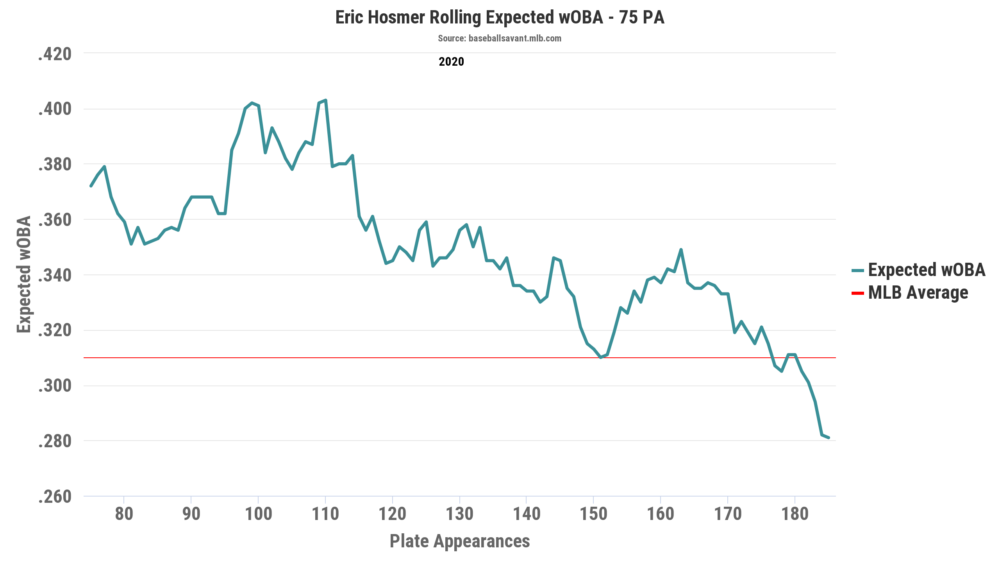
That downward slope suggests that the improved numbers are more of a flash in the pan than a new reality for Hosmer. I don’t want you to think I’m concerned about him, though.
When you zoom out, you’ll see that he was really just the same Hosmer as usual:
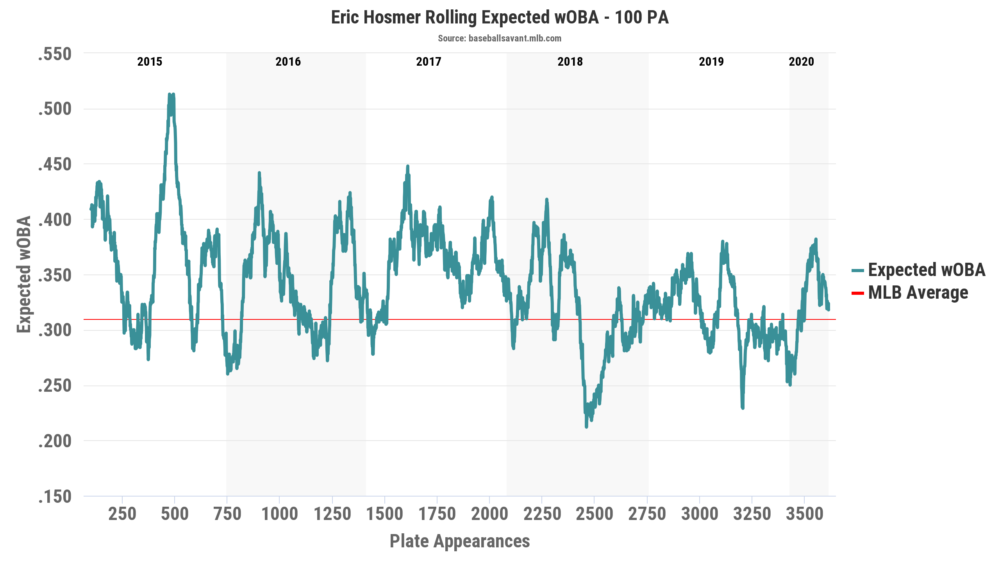
That little sliver of grey to the far right of chart above? That’s the 2020 data. When we say 2020 was a small sample, we mean it. For guys like Hosmer, seeing the big picture reminds us that we should try to take the small sample in the proper context.
Tier 5: Deep League Options
No. 20: Christian Walker (Arizona Diamondbacks)
There is nothing wrong with Christian Walker. He should threaten to hit 30 home runs, can drive in 80 runners, and should hit above .250. All very respectable things, to be sure. The thing is, in the type of format these rankings are geared towards, he’s mostly just a floor.
My best guess is that in that type of league, he’ll be drafted, dropped, and picked back up several times throughout the course of the season. He’s a guy that many managers will look to replace during cold spells and a guy that will get picked up to replace injured bats or because he’s on a hot streak.
Now there’s nothing wrong with that. He’s a solid corner infielder in 15-team leagues, and his role as the everyday first baseman and the three-hole hitter is all but guaranteed. That kind of floor has a really nice place in a lot of formats—just not so much in shallow 10- and 12-teamers, and especially not shallow 10- and 12-teamers that don’t have a corner infield slot.
No. 21: Miguel Sanó (Minnesota Twins)
I get it—you want to chase that 40-home run, 100 RBI dragon. I do understand the appeal. His power is unquestionable, and hitting in the middle of the Twins batting order is a good place to pile up counting stats. He’s also still only 27, is coming off another year with an average exit velocity above 94 miles per hour and a hard hit rate north of 57%.
Here’s the thing, though—that power only matters when he makes contact, and that is not a talent Sanó has shown in his time in the major leagues. He also doesn’t have much speed and is a pretty rough defender no matter where the Twins plug him in.
One of the most jarring flaws in his game, though, is the strikeouts. Few players take a third strike as often as Sanó. He has yet to finish a season with a strikeout rate under 35.5%, and his whiff rate was once again among the worst in baseball.
Speaking of strikeout rate, you’ll see a rolling chart of his strikeout rate below. You know how all of the rolling charts I’ve posted in these previews have that red MLB Average line in them? Well, this one doesn’t. If you look at the y-axis of the table, you’ll probably figure out why.
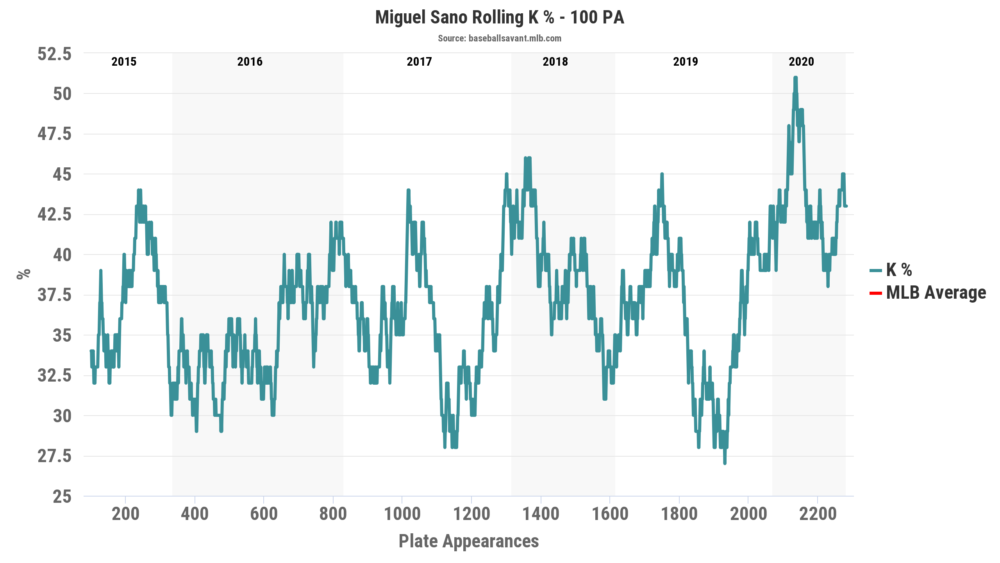
Is there a reality where Sano plays more than 117 games (a mark he still has yet to reach in the majors) and brutalizes enough baseballs to be a top-12 first baseman? Sure. I’m just suggesting that it will be very difficult to keep him in your lineup when he’s striking out as often as 50% of the time over a 100 plate appearance stretch.
His slumps are just absolutely devastating, and with huge durability concerns and a likely demotion from time to time in the lineup, I just don’t think he’s a guy you should draft in a 10- or 12-team format. Save yourself the headache and just get someone else.
He’ll be ranked here because he’s one of the only folks at this part of the list who you could envision as a top-10 guy and that’s worth something, but if I were you, I wouldn’t chase it.
No. 22: C.J. Cron (Colorado Rockies)
I’m not quite ready to name Cron the starter in Colorado yet, which means I’m also not ready to rank him better than this quite yet. Cron has real power, but he’s struggled to stay healthy throughout his career. He could very well hit 30 home runs and get a batting average boost to about .260 if he played 130 or more games, but he’s only ever done that once in his major league career (2018).
There are also still a lot of corner infielders in Colorado (McMahon, Colton Welker, and Josh Fuentes), and they’ll also need to find ways to make room for their bevy of middle infielders and outfielders. The Rockies were notorious for how often they shifted their lineup from day to day, and even a healthy Cron could be taking two games off each week.
No. 23: Andrew Vaughn (Chicago White Sox)
That rumbling in the distance? That’s the Vaughn hype train picking up passengers. The top prospect on the South Side has impressed this spring and has huge upside with an outstanding hit tool and excellent power. The only issue with Vaughn, from a 2021 perspective, is that he has zero double-A at bats.
With an open roster spot in Chicago, Vaughn is very likely to break camp with the team—and that’s a very exciting thing. I would just add that adjusting to the big leagues is tough, and while he’s an advanced prospect, it’s not as though he was tearing the cover off of the ball in the minor leagues.
You’re hoping for 20-25 home runs and a decent batting average. His OBP floor should be pretty good as well. I think you’d be hard-pressed to rank him much higher than this knowing that the floor is fizzling out with power and being sent down.
Tier 6: Even Deeper League Options
No. 24:
Jake Cronenworth (San Diego Padres)
Fantasy managers, much like the Padres real manager, probably aren’t quite sure where to play Cronenworth at this point. I’ve ranked him highest as a second baseman, and here’s the write-up from that piece:
Statcast loved his game in 2020, and it’s hard to forget how amazing he was when he debuted for the Padres. What might have been lost in the short season, though, was that he was not consistently as awesome as you might have thought for those 54 games he played in the regular season:
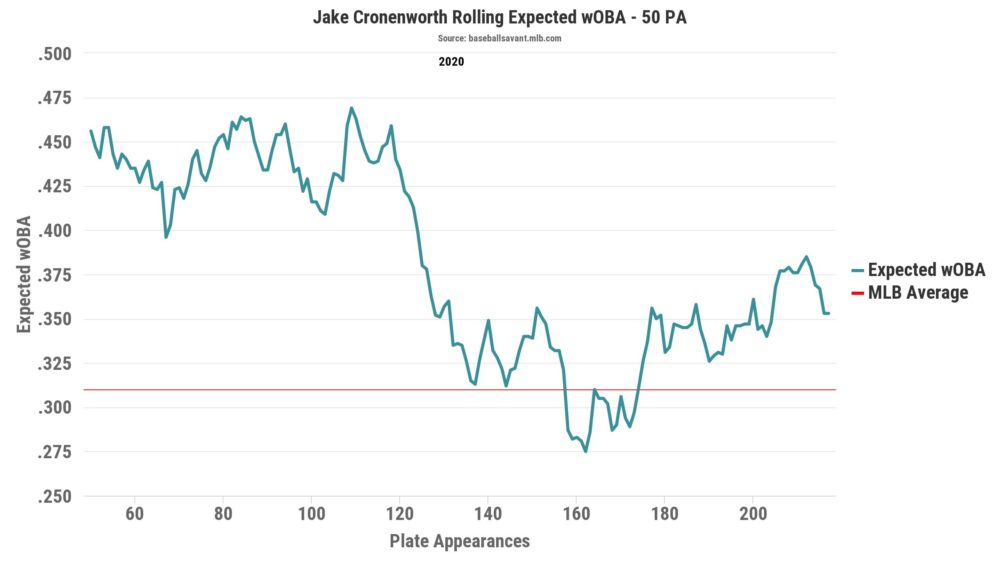
Now I don’t want you to think that I’m saying Cronenworth is a bad player—he seemed to adjust over time as pitchers gave him new looks, and seeing rookies rebound after they hit a bit of a valley is a very good sign.
The real issue for Cronenworth will be finding plate appearances. There are no fewer than four players on the Padres projected opening day roster who can play second base, and three of them are actually on the second base list (sorry, Jorge Mateo).
I can’t exactly envision a clear path to 120 games, and because of that, it’s also tough to see more than 10 home runs or steals. If you guaranteed me a full season of plate appearances, Cronenworth likely finds himself in the fourth or fifth tier.
You can’t do that, though, so I guess this is where we have to land for now.
No. 25: Carlos Santana (Kansas City Royals)
On one hand, Kansas City is a tough place to hit home runs and a tough place to drive in runners or be driven in. On the other hand, Kansas City has basically no choice but to start Santana every single day at first base if they want to resemble a major league club, so that does bode well for his fantasy prospects.
While we’ve seen him hit 30 home runs as recently as 2019, Santana’s most bankable skill is probably his plate discipline, as he should walk as often or more often than he strikes out and maintain a batting average well above .350. It’s hard to project him for more than 25 home runs or 80 RBI, though, and even that feels like a stretch for a guy who can go on prolonged slumps where he bats less than .220.
Of course, if you play in an OBP league, you can probably move him up a tier, or at the very least, to the top of this tier.
No. 26:
Yuli Gurriel (Houston Astros)
When it comes to batting average and RBI, we don’t have a lot of questions about Gurriel. He’s going to do pretty well in both categories. Even going into his age-36 season, a sub-15% strikeout rate and 80 RBI feel sort of like a given batting behind the stacked top half of the Astros lineup (2020 regular season struggles aside).
When it comes to power, we really only have one question—are you willing to believe that Gurriel can recreate that insane power spike from the second half of 2019? It’s worth noting that we really only saw it for half a season, as he was pretty bland for the first few months of 2019. To put that unfathomable run into perspective, here’s a rolling chart of Gurriel’s actual slugging percentage over the course of his career:
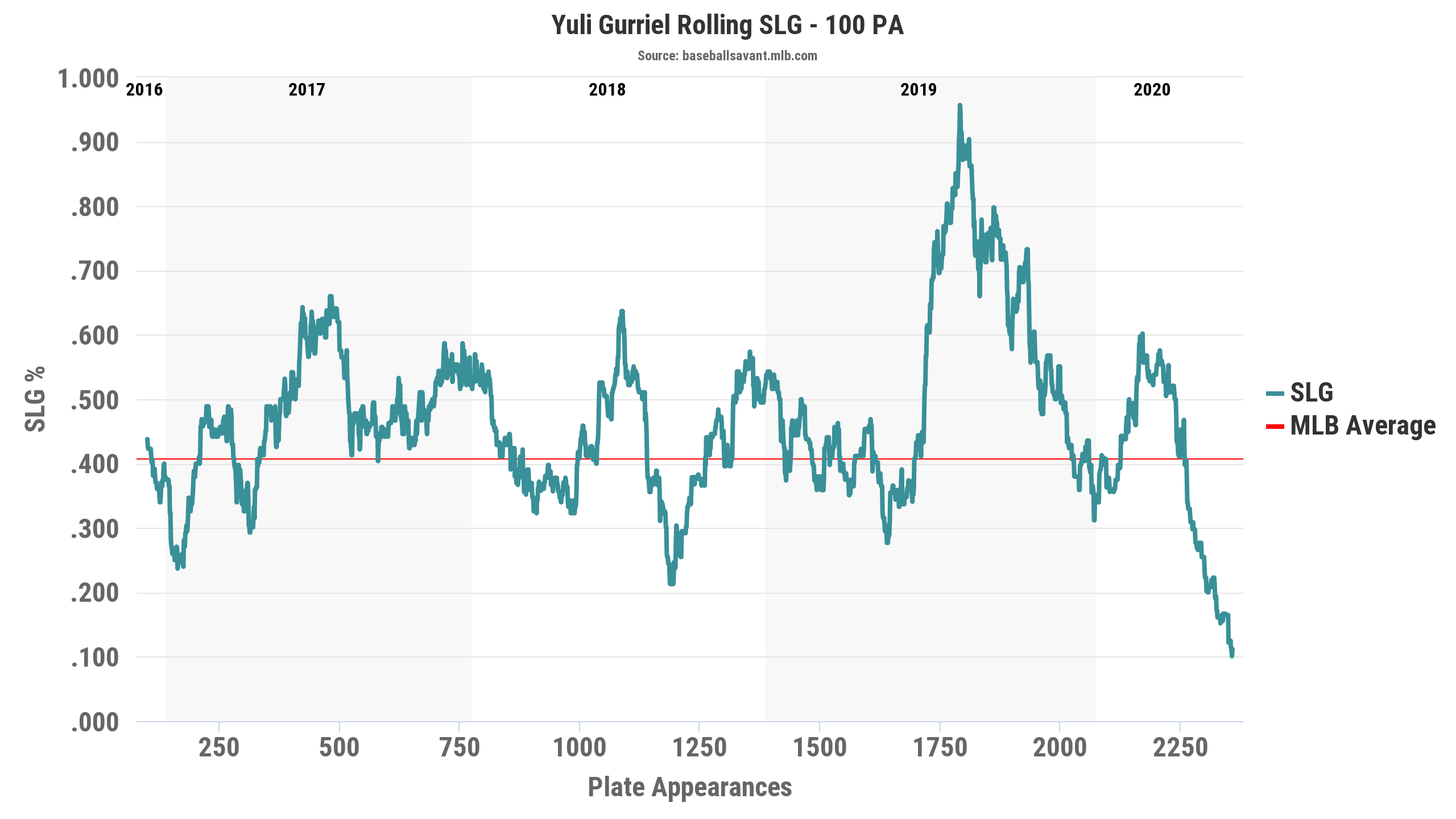
Do you see the spike now? And how it is utterly different than all of the other data we have on Gurriel? I am inclined to believe that the spike is an exception and that we should be happy with the normal version of Gurriel. That spike and the possibility that he could do it again keeps him in this tier, but that’s about it.
No. 27: Jeimer Candelario (Detroit Tigers)
The 27-year-old corner infielder flashed some promise during 2020, batting .297 with respectable plate discipline and a little bit of pop. Statcast mostly believed in the results through an expected batting average of .277 and an expected slugging of .469, and those kinds of numbers would be an appealing sight for my sore Tigers’ fan eyes.
My guess is that the real Candelario is more like a guy who can hit 20 bombs and maybe bat .260 or so, and while that’s perfectly acceptable for real baseball or an AL-only league, it’s no good for shallow 10- or 12-teamers, regardless of whether they have a middle infield slot.
No. 28: Tommy La Stella (San Francisco Giants)
La Stella finds himself slightly higher in the second base rankings and is more likely to be used at that position for fantasy. Here’s the blurb from those rankings on La Stella:
I don’t want it to seem like I dislike La Stella, because that would be inaccurate. I’m a big fan after being down on him during his initial breakout and love the versatility and contact ability.
That said, the 16 home runs in 80 games back in 2019 still seem very much like an anomaly compared to the rest of his career, and it’s tough to project more than 16 home runs in 2021. La Stella could find himself playing a bit less than every day with guys like Wilmer Flores and Evan Longoria also demanding at least a couple of at-bats each week and not quite enough spots to play them all.
An added DH helps a little, but with no speed and limited power, his shallow league relevance is limited to hoping he can flash the kind of power he showed in 2019. I’m not saying he can’t do that, I’m just saying you don’t need to draft him in 10- and 12-teamers unless it’s a points league, as he almost never strikes out and should hit high in the order.
No. 29: Renato Núñez (Detroit Tigers)
He’s a power hitter, and only a power hitter. After signing a minor league deal in Detroit, he’ll have a clear path to being an everyday first baseman for what I expect will be a bad offense.
Comerica Park is a pretty big park and would make it tough for him to reach 30 home runs even if he had a spot in the lineup every day. While his new home park suppresses home runs, it still plays favorably for hitters thanks to those huge power alleys, so he might trade five home runs for about 10 points of batting average. It’s not great, but at least it isn’t nothing.
Hitting 30 home runs isn’t as impressive as it used to be, but it’s still enough to get ranked.
No. 30: Evan White (Seattle Mariners)
This was one of the biggest snubs from my original rankings, so I had to get him in here somewhere. He’s a little difficult to rank, as he’s yet another one of those “could hit 30 home runs and bat .240” corner infielders, only unlike some of the others, he hasn’t actually done it yet.
There are things to like in the profile, though. First, he has previously displayed a strong hit tool in the past, though he’s shifted to a more aggressive approach over the last few years. Regardless, the strikeout rate should come down at least some in 2021. If he can settle in around 25% or so, he’ll be in a much better place than the 41.6% we say in 2020. White is also a very strong defender at first, and with Dan Vogelbach out of the way, he should be the everyday first baseman for the Mariners.
The biggest knocks on him are that he doesn’t walk all that much (he’s about league average in that respect), and his batting average floor is quite a bit lower than some others due to the free-swinging approach.
Honorable Mentions
Jesús Aguilar (Miami Marlins)
2020 gave us a dose of something sort of in-between his breakout 2018 and his disappointing sequel in 2019. While Miami is a particularly cavernous home ballpark, it’s also one of the few situations where Aguilar will get a chance to play every day, so I suppose it’s the best a potential fantasy manager could hope for, I guess.
In a 15-team or NL-only fantasy league you could do well to use a late pick on his 20-25 home runs and a batting average that shouldn’t hurt you too badly—just don’t go looking for anything more than that.
3/26 Update: With news that he’ll share the role with Garrett Cooper, I just couldn’t keep him ranked.
Nate Lowe (Texas Rangers)
Lowe’s hype has stalled considerably since he broke out in 2018 in the Rays’ organization, but there was enough there for the Rangers to make a trade for him and hand him a starting job.
Strikeout rates have been and will likely continue to be a pressing issue, but given a full season, I’d expect Lowe to hit 20-25 home runs, take his fair share of walks, and maybe hit .250 or so. That last part is highly dependent on his ability to limit the strikeouts, though, and makes him a bit of a gamble even in deeper leagues.
Rowdy Tellez (Toronto Blue Jays)
In deeper leagues, this might be one of the more rare examples of where I’d rank him lower than this, but Tellez has the strength to hit 25-30 home runs if given the opportunity.
The crowded state of the Blue Jays lineup means Tellez is likely to platoon with Randal Grichuk, but if something were to free up space or if Tellez were to go on another hot streak like he did in 2020, I think he’d force both the Blue Jays and deep-league managers to pay closer attention to him.
Ryan McMahon (Colorado Rockies)
He’ll play, he’ll hit 25 home runs or so, and that’s all we really can say about him. He’ll be streamable in DFS or extremely deep daily leagues when facing favorable matchups in Coors (he’s considerably better against lefties than righties, though still quite average), and that’s about it.
Hunter Dozier (Kansas City Royals)
I guess the walk rate spike was interesting and he did steal four bases for some reason. 2019’s 26 home runs, 84 RBI, and .279 batting average probably represented the ceiling for Dozier, and even that was barely a top-20 first baseman (had he been eligible at that position at the time).
Joey Votto (Cincinnati Reds)
If there’s a silver lining to his recent struggles, it’s that his 11 home runs in 54 games is nearly as many as he hit in 2018 or 2019 when he played over 140 games. At 37, his bat speed has slowed down just a hair so that he no longer can walk as often as he strikes out if he wants to make contact on certain pitches, and while I love Votto and everything that he is, he is no longer a viable fantasy option.
Wilmer Flores (San Francisco Giants)
You’d assume there’d be more hype for a guy who slugged .515 with 12 home runs over 55 games, but you’d be pretty wrong. As of this moment, Flores is on the outside of the starting lineup looking in thanks to the addition of La Stella and the everlasting presence of Brandon Belt. With those two lefties blocking the path and teammates Austin Slater and Evan Longoria also demanding a few plate appearances each week, it will be hard for Flores to be fantasy-relevant.
Brandon Belt (San Francisco Giants)
Speaking of Belt, he hit a shocking .309/.425/.591 over 51 games in 2020, which was good for a 172 wRC+. However, there’s doubt creeping in as to whether he’ll be ready for opening day due to a heel injury. We’ve seen hot streaks from Belt before, so while he might be worth a short-term flyer during the regular season, this is not a place to use draft capital.
Garrett Cooper (Miami Marlins)
While I have respect for the .281 career batting average in 168 major league games, a lack of a full-time role combined with being a Marlin and having fairly limited home run potential makes it tough to generate any real excitement.
Colin Moran (Pittsburgh Pirates)
Moran was exciting news early in 2020, and I was flooded with add/drop questions with him as the add. Things got back to normal before long, though, as more and more people realized that he’s really just a lefty with decent pop against righties who hits in the middle of a bad lineup.
Jared Walsh (Los Angeles Angels)
I have no idea what to make of him. In his 34 games in 2019, he struck out a whopping 40.2% of the time and limped to a .203 batting average with just one home run. In his 32 games in 2020, he struck out just 13.9% of the time and hit 9 home runs with a .293 batting average.
If I wasn’t literally looking at his stats right now, I’d swear we were talking about two completely different hitters. There’s definitely some power here, but with questions as to how often he’ll play and whether the dramatic strikeout changes will stick, he’s best left as a watchlist candidate until further notice.
Photos by David J. Griffin & Dustin Bradford/Icon Sportswire | Adapted by Justin Redler (@reldernitsuj on Twitter)
